From Bare Soil to Green Infrastructure: Micrometeorological Benefits from the Restoration of a Small Urban Park in a Mediterranean City
Abstract
1. Introduction
2. Materials and Methods
2.1. Study Site
2.2. Data and Methods
2.3. Meteorological Conditions
3. Results
3.1. Thermal Comfort
3.2. Changes in the Reflectance of the UGS
3.3. Changes in the Thermal Behavior of the UGS
4. Discussion
5. Conclusions
Author Contributions
Funding
Data Availability Statement
Acknowledgments
Conflicts of Interest
Appendix A
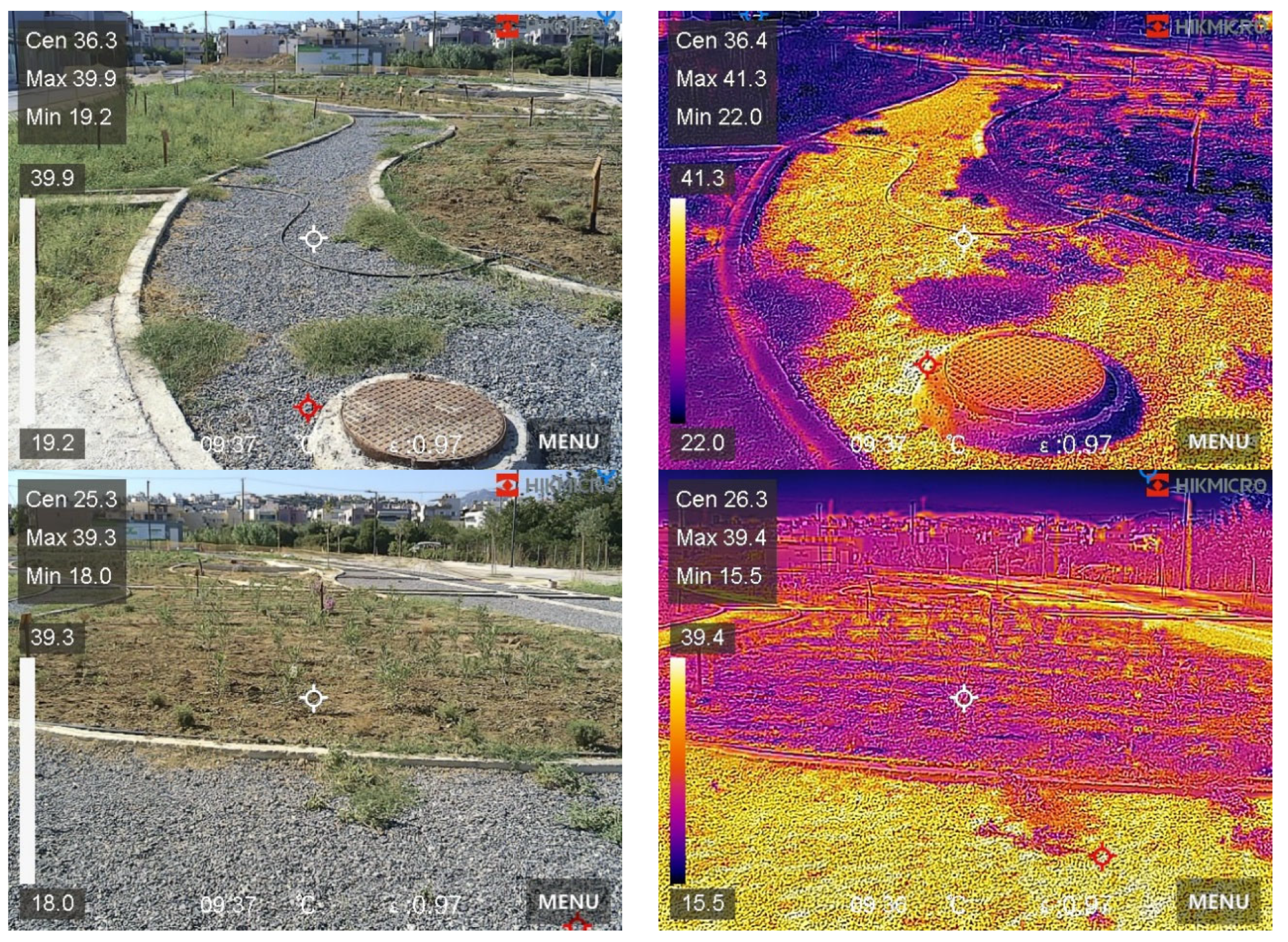
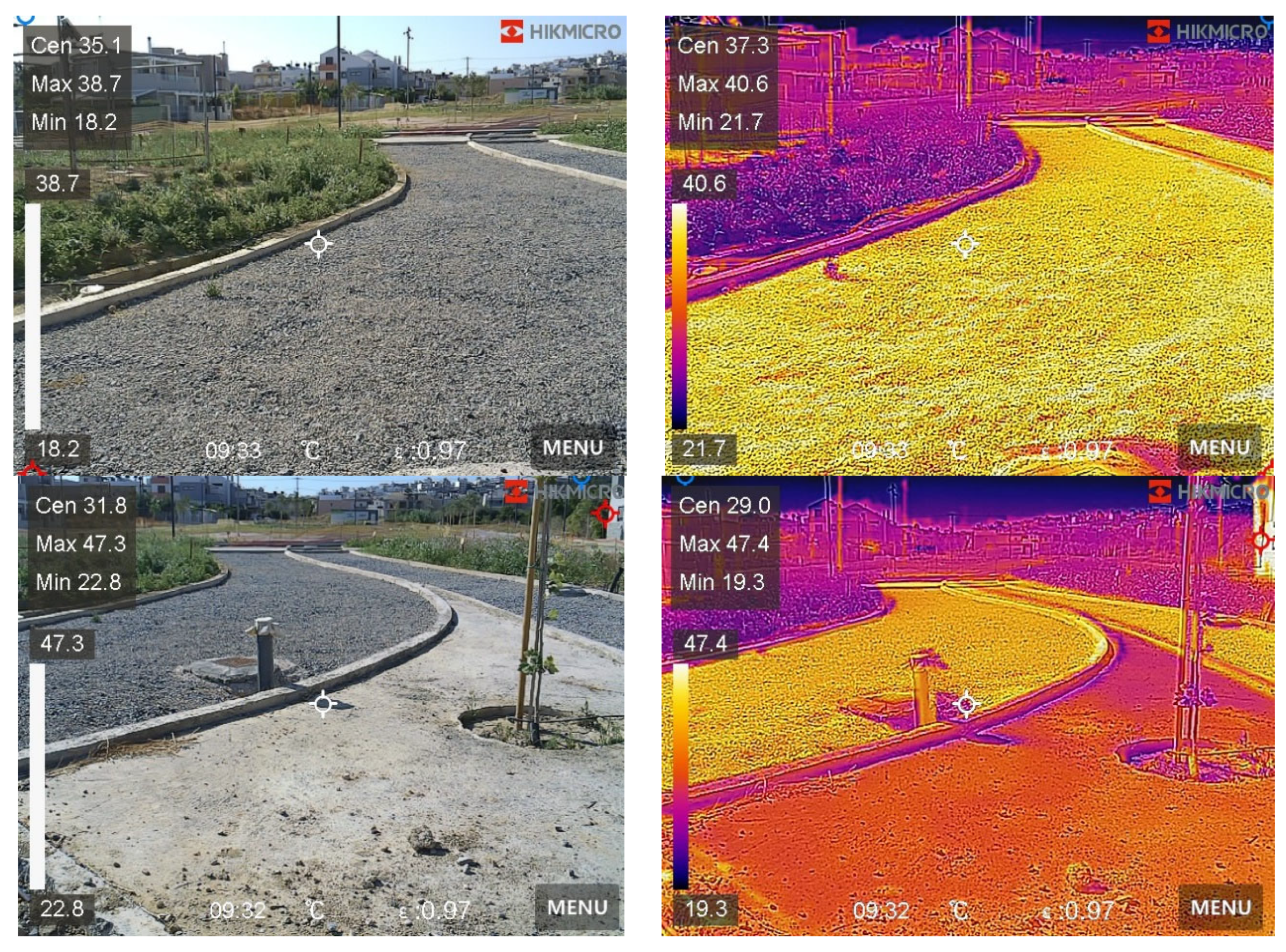
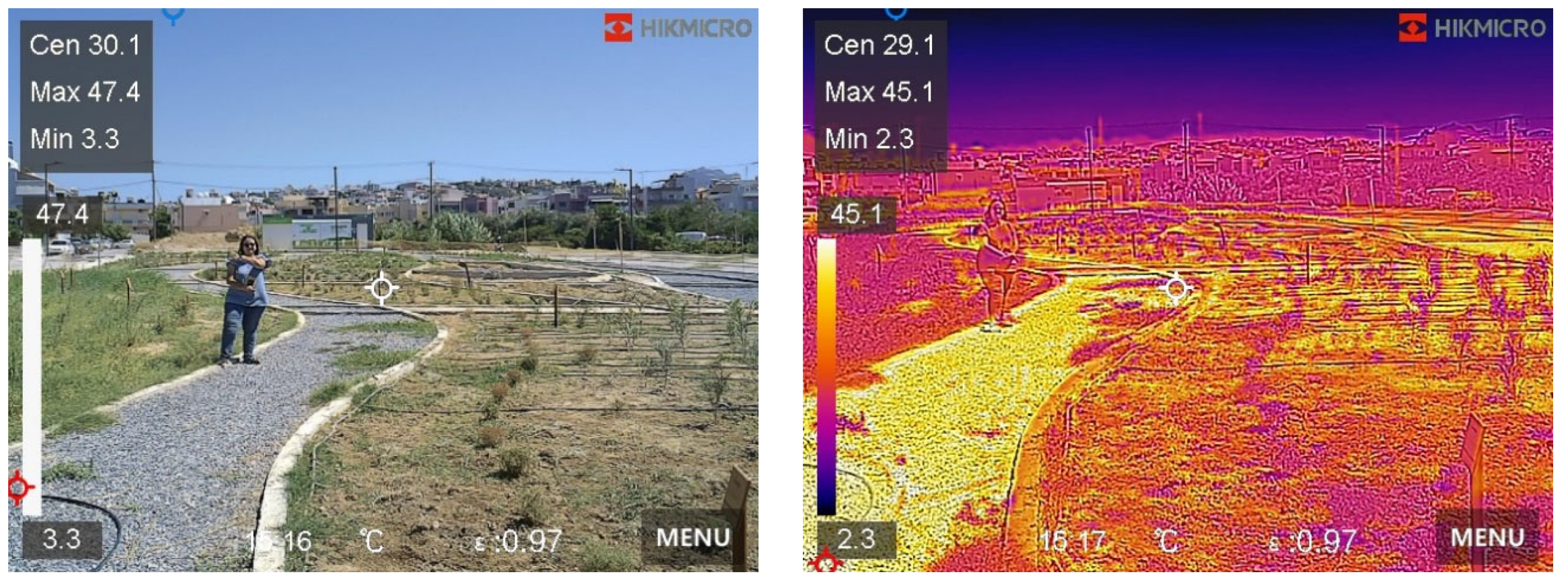
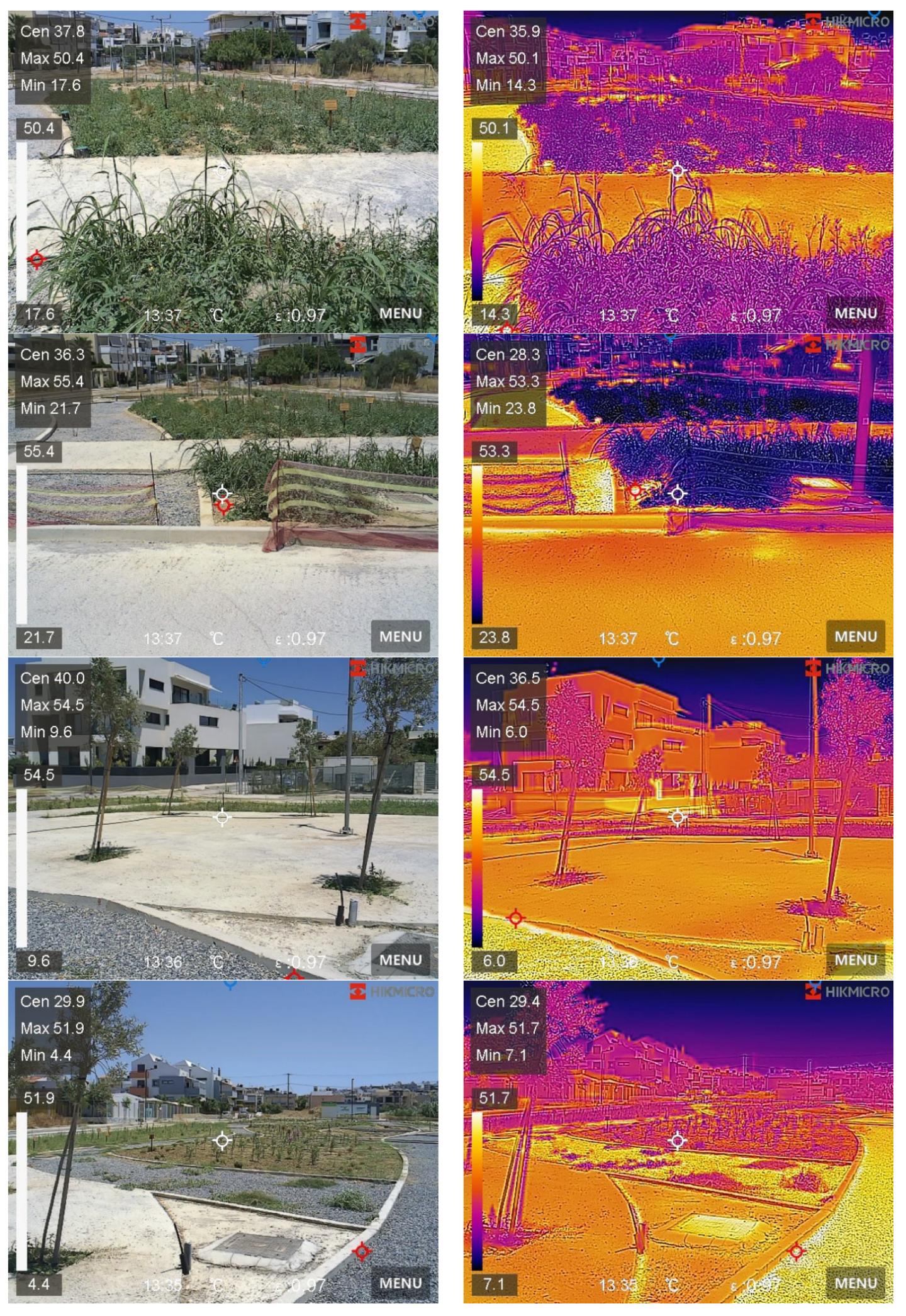
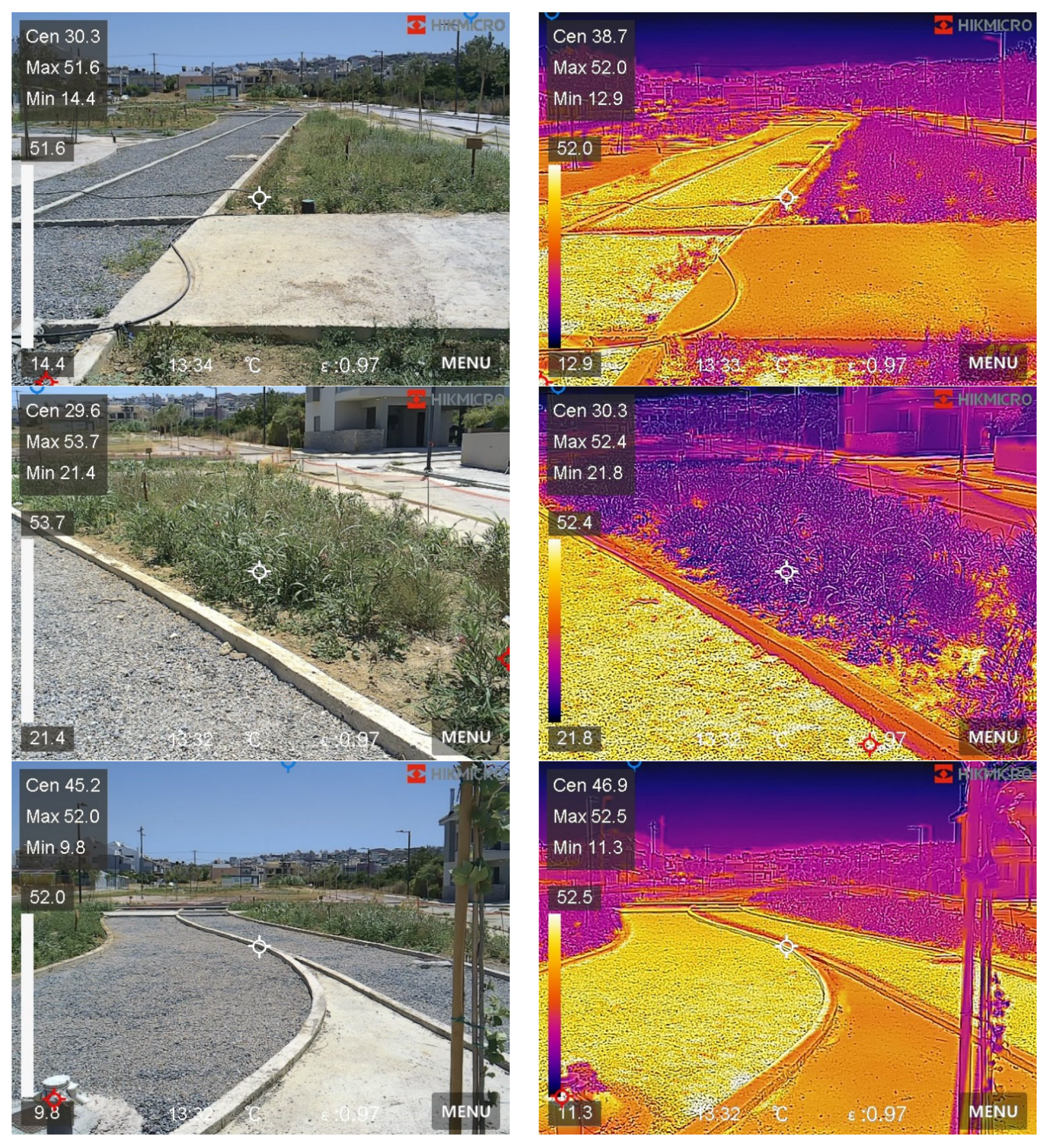
References
- García, D.H. Spatio-temporal analysis of the urban green infrastructure of the city of Granada (Spain) as a heat mitigation measure using high-resolution images Sentinel 3. Urban For. Urban Green. 2023, 87, 128061. [Google Scholar] [CrossRef]
- Marando, F.; Heris, M.P.; Zulian, G.; Udías, A.; Mentaschi, L.; Chrysoulakis, N.; Parastatidis, D.; Maes, J. Urban heat island mitigation by green infrastructure in European Functional Urban Areas. Sustain. Cities Soc. 2022, 77, 103564. [Google Scholar] [CrossRef]
- Najah, F.T.; Abdullah, S.F.K.; Abdulkareem, T.A. Urban land use changes: Effect of green urban spaces transformation on urban heat islands in Baghdad. Alex. Eng. J. 2023, 66, 555–571. [Google Scholar] [CrossRef]
- Pugh, T.A.; MacKenzie, A.R.; Whyatt, J.D.; Hewitt, C.N. Effectiveness of green infrastructure for improvement of air quality in urban street canyons. Environ. Sci. Technol. 2012, 46, 7692–7699. [Google Scholar] [CrossRef]
- Salih, K.; Báthoryné Nagy, I.R. Review of the Role of Urban Green Infrastructure on Climate Resiliency: A Focus on Heat Mitigation Modelling Scenario on the Microclimate and Building Scale. Urban Sci. 2024, 8, 220. [Google Scholar] [CrossRef]
- Wong, N.H.; Tan, C.L.; Kolokotsa, D.D.; Takebayashi, H. Greenery as a mitigation and adaptation strategy to urban heat. Nat. Rev. Earth Environ. 2021, 2, 166–181. [Google Scholar] [CrossRef]
- Nastos, P.; Saaroni, H. Living in Mediterranean cities in the context of climate change: A review. Int. J. Climatol. 2024, 44, 3169–3190. [Google Scholar] [CrossRef]
- Diffenbaugh, N.S.; Giorgi, F. Climate change hotspots in the CMIP5 global climate model ensemble. Clim. Change 2012, 114, 813–822. [Google Scholar] [CrossRef]
- Lionello, P. The Climate of the Mediterranean Region: From the Past to the Future; Elsevier: Oxford, UK, 2012. [Google Scholar]
- Lionello, P.; Malanotte-Rizzoli, P.; Boscolo, R. Mediterranean Climate Variability; Elsevier: Amsterdam, The Netherlands, 2006; Volume 4. [Google Scholar]
- Xoplaki, E.; González-Rouco, J.F.; Luterbacher, J.; Wanner, H. Mediterranean summer air temperature variability and its connection to the large-scale atmospheric circulation and SSTs. Clim. Dyn. 2003, 20, 723–739. [Google Scholar] [CrossRef]
- Kumar, P.; Debele, S.E.; Khalili, S.; Halios, C.H.; Sahani, J.; Aghamohammadi, N.; de Fatima Andrade, M.; Athanassiadou, M.; Bhui, K.; Calvillo, N. Urban heat mitigation by green and blue infrastructure: Drivers, effectiveness, and future needs. Innovation 2024, 5, 100588. [Google Scholar] [CrossRef]
- Oke, T.R. Boundary Layer Climates; Routledge: London, UK, 2002. [Google Scholar]
- Linares, C.; Díaz, J.; Negev, M.; Martínez, G.S.; Debono, R.; Paz, S. Impacts of climate change on the public health of the Mediterranean Basin population-current situation, projections, preparedness and adaptation. Environ. Res. 2020, 182, 109107. [Google Scholar] [CrossRef]
- Wu, Q.; Huang, Y.; Irga, P.; Kumar, P.; Li, W.; Wei, W.; Shon, H.K.; Lei, C.; Zhou, J.L. Synergistic control of urban heat island and urban pollution island effects using green infrastructure. J. Environ. Manag. 2024, 370, 122985. [Google Scholar] [CrossRef]
- Emmanuel, R.; Loconsole, A. Green infrastructure as an adaptation approach to tackling urban overheating in the Glasgow Clyde Valley Region, UK. Landsc. Urban Plan. 2015, 138, 71–86. [Google Scholar] [CrossRef]
- Lei, Y.; Davies, G.M.; Jin, H.; Tian, G.; Kim, G. Scale-dependent effects of urban greenspace on particulate matter air pollution. Urban For. Urban Green. 2021, 61, 127089. [Google Scholar] [CrossRef]
- Proutsos, N.D.; Solomou, A.D. Urban Green Spaces as an Effective Tool to Regulate Urban Climate and Biodiversity: Current Research and Challenges. Land 2025, 14, 497. [Google Scholar] [CrossRef]
- Rodrigues, B.N.; Junior, V.E.M.; Canteras, F.B. Green Infrastructure as a solution to mitigate the effects of climate change in a coastal area of social vulnerability in Fortaleza (Brazil). Environ. Adv. 2023, 13, 100398. [Google Scholar] [CrossRef]
- Sebastiani, A.; Marando, F.; Manes, F. Mismatch of regulating ecosystem services for sustainable urban planning: PM10 removal and urban heat island effect mitigation in the municipality of Rome (Italy). Urban For. Urban Green. 2021, 57, 126938. [Google Scholar] [CrossRef]
- Speak, A.; Montagnani, L.; Wellstein, C.; Zerbe, S. The influence of tree traits on urban ground surface shade cooling. Landsc. Urban Plan. 2020, 197, 103748. [Google Scholar] [CrossRef]
- Van Oijstaeijen, W.; e Silva, M.F.; Back, P.; Collins, A.; Verheyen, K.; De Beelde, R.; Cools, J.; Van Passel, S. The Nature Smart Cities business model: A rapid decision-support and scenario analysis tool to reveal the multi-benefits of green infrastructure investments. Urban For. Urban Green. 2023, 84, 127923. [Google Scholar] [CrossRef]
- Liberalesso, T.; Cruz, C.O.; Silva, C.M.; Manso, M. Green infrastructure and public policies: An international review of green roofs and green walls incentives. Land Use Policy 2020, 96, 104693. [Google Scholar] [CrossRef]
- United Nations Environment Programme and United Nations Human Settlements Programme (UN-Habitat). Global Environment Outlook for Cities–GEO for Cities: Towards Green and Just Cities. Available online: https://unhabitat.org/sites/default/files/2021/11/geocities_updated.pdf (accessed on 6 February 2025).
- Halder, N.; Kumar, M.; Deepak, A.; Mandal, S.K.; Azmeer, A.; Mir, B.A.; Nurdiawati, A.; Al-Ghamdi, S.G. The role of urban greenery in enhancing thermal comfort: Systematic review insights. Sustainability 2025, 17, 2545. [Google Scholar] [CrossRef]
- Gunawardena, K.R.; Wells, M.J.; Kershaw, T. Utilising green and bluespace to mitigate urban heat island intensity. Sci. Total Environ. 2017, 584, 1040–1055. [Google Scholar] [CrossRef] [PubMed]
- Yu, Q.; Ji, W.; Pu, R.; Landry, S.; Acheampong, M.; O’Neil-Dunne, J.; Ren, Z.; Tanim, S.H. A preliminary exploration of the cooling effect of tree shade in urban landscapes. Int. J. Appl. Earth Obs. Geoinf. 2020, 92, 102161. [Google Scholar] [CrossRef]
- Taha, H. Urban climates and heat islands: Albedo, evapotranspiration, and anthropogenic heat. Energy Build. 1997, 25, 99–103. [Google Scholar] [CrossRef]
- Winbourne, J.B.; Jones, T.S.; Garvey, S.M.; Harrison, J.L.; Wang, L.; Li, D.; Templer, P.H.; Hutyra, L. Tree transpiration and urban temperatures: Current understanding, implications, and future research directions. BioScience 2020, 70, 576–588. [Google Scholar] [CrossRef]
- Proutsos, N.D.; Solomou, A.D.; Petropoulou, M.; Chatzipavlis, N.E. Micrometeorological and hydraulic properties of an urban green space on a warm summer day in a Mediterranean City (Attica–Greece). Land 2022, 11, 2042. [Google Scholar] [CrossRef]
- Tan, C.L.; Wong, N.H.; Tan, P.Y.; Jusuf, S.K.; Chiam, Z.Q. Impact of plant evapotranspiration rate and shrub albedo on temperature reduction in the tropical outdoor environment. Build. Environ. 2015, 94, 206–217. [Google Scholar] [CrossRef]
- Chang, C.-R.; Li, M.-H. Effects of urban parks on the local urban thermal environment. Urban For. Urban Green. 2014, 13, 672–681. [Google Scholar] [CrossRef]
- Nitidara, N.P.A.; Sarwono, J.; Suprijanto, S.; Soelami, F.N. The multisensory interaction between auditory, visual, and thermal to the overall comfort in public open space: A study in a tropical climate. Sustain. Cities Soc. 2022, 78, 103622. [Google Scholar] [CrossRef]
- Núñez, J.M.; Santamaría, A.; Avila, L.; Perez-De La Mora, D. Using Local Entropy Mapping as an Approach to Quantify Surface Temperature Changes Induced by Urban Parks in Mexico City. Land 2024, 13, 1701. [Google Scholar] [CrossRef]
- Proutsos, N.D.; Solomou, A.D.; Stefanidis, S.P.; Tsiros, I.X. Reflectance and Thermal Micrometeorological Characteristics of an Urban Green Space in the Mediterranean During July’s 2023 Heatwave. Land 2025, 14, 194. [Google Scholar] [CrossRef]
- Tsiros, I.X.; Hoffman, M.E. Thermal and comfort conditions in a semi-closed rear wooded garden and its adjacent semi-open spaces in a Mediterranean climate (Athens) during summer. Archit. Sci. Rev. 2014, 57, 63–82. [Google Scholar] [CrossRef]
- Hamada, S.; Ohta, T. Seasonal variations in the cooling effect of urban green areas on surrounding urban areas. Urban For. Urban Green. 2010, 9, 15–24. [Google Scholar] [CrossRef]
- Meili, N.; Manoli, G.; Burlando, P.; Carmeliet, J.; Chow, W.T.; Coutts, A.M.; Roth, M.; Velasco, E.; Vivoni, E.R.; Fatichi, S. Tree effects on urban microclimate: Diurnal, seasonal, and climatic temperature differences explained by separating radiation, evapotranspiration, and roughness effects. Urban For. Urban Green. 2021, 58, 126970. [Google Scholar] [CrossRef]
- Yang, J.; Bou-Zeid, E. Should cities embrace their heat islands as shields from extreme cold? J. Appl. Meteorol. Climatol. 2018, 57, 1309–1320. [Google Scholar] [CrossRef]
- Cabon, V.; Quénol, H.; Dubreuil, V.; Ridel, A.; Bergerot, B. Urban heat island and reduced habitat complexity explain spider community composition by excluding large and heat-sensitive species. Land 2024, 13, 83. [Google Scholar] [CrossRef]
- Hernandez, R.C.; Camerin, F. The application of ecosystem assessments in land use planning: A case study for supporting decisions toward ecosystem protection. Futures 2024, 161, 103399. [Google Scholar] [CrossRef]
- Longato, D.; Cortinovis, C.; Balzan, M.; Geneletti, D. A method to prioritize and allocate nature-based solutions in urban areas based on ecosystem service demand. Landsc. Urban Plan. 2023, 235, 104743. [Google Scholar] [CrossRef]
- Mell, I. Examining the role of green infrastructure as an advocate for regeneration. Front. Sustain. Cities 2022, 4, 731975. [Google Scholar] [CrossRef]
- Ige-Elegbede, J.; Pilkington, P.; Orme, J.; Williams, B.; Prestwood, E.; Black, D.; Carmichael, L. Designing healthier neighbourhoods: A systematic review of the impact of the neighbourhood design on health and wellbeing. Cities Health 2022, 6, 1004–1019. [Google Scholar] [CrossRef]
- Rahman, M.A.; Moser, A.; Rötzer, T.; Pauleit, S. Comparing the transpirational and shading effects of two contrasting urban tree species. Urban Ecosyst. 2019, 22, 683–697. [Google Scholar] [CrossRef]
- Cheela, V.S.; John, M.; Biswas, W.; Sarker, P. Combating urban heat island effect—A review of reflective pavements and tree shading strategies. Buildings 2021, 11, 93. [Google Scholar] [CrossRef]
- Kolimenakis, A.; Solomou, A.D.; Proutsos, N.; Avramidou, E.V.; Korakaki, E.; Karetsos, G.; Maroulis, G.; Papagiannis, E.; Tsagkari, K. The socioeconomic welfare of urban green areas and parks; a literature review of available evidence. Sustainability 2021, 13, 7863. [Google Scholar] [CrossRef]
- Cohen, P.; Potchter, O.; Matzarakis, A. Daily and seasonal climatic conditions of green urban open spaces in the Mediterranean climate and their impact on human comfort. Build. Environ. 2012, 51, 285–295. [Google Scholar] [CrossRef]
- Reyes-Paecke, S.; Gironás, J.; Melo, O.; Vicuna, S.; Herrera, J. Irrigation of green spaces and residential gardens in a Mediterranean metropolis: Gaps and opportunities for climate change adaptation. Landsc. Urban Plan. 2019, 182, 34–43. [Google Scholar] [CrossRef]
- Egerer, M.; Annighöfer, P.; Arzberger, S.; Burger, S.; Hecher, Y.; Knill, V.; Probst, B.; Suda, M. Urban oases: The social-ecological importance of small urban green spaces. Ecosyst. People 2024, 20, 2315991. [Google Scholar] [CrossRef]
- Perini, K.; Calise, C.; Castellari, P.; Roccotiello, E. Microclimatic and environmental improvement in a Mediterranean city through the regeneration of an area with nature-based solutions: A case study. Sustainability 2022, 14, 5847. [Google Scholar] [CrossRef]
- Proutsos, N.D.; Tsiros, I.X.; Nastos, P.; Tsaousidis, A. A note on some uncertainties associated with Thornthwaite’s aridity index introduced by using different potential evapotranspiration methods. Atmos. Res. 2021, 260, 105727. [Google Scholar] [CrossRef]
- Tsiros, I.X.; Nastos, P.; Proutsos, N.D.; Tsaousidis, A. Variability of the aridity index and related drought parameters in Greece using climatological data over the last century (1900–1997). Atmos. Res. 2020, 240, 104914. [Google Scholar] [CrossRef]
- UNEP. World Atlas of Desertification; UNEP: Cambridge, UK, 1992. [Google Scholar]
- Thornthwaite, C. Una aproximación para una clasificación racional del clima. Geogr. Rev. 1948, 38, 55–94. [Google Scholar] [CrossRef]
- Thornthwaite, C.W.; Mather, J. The water balance. Publ. Climatol. 1955, VIII, 1–104. [Google Scholar]
- Proutsos, N.; Korakaki, E.; Bourletsikas, A.; Solomou, A.; Avramidou, E.; Georgiadis, C.; Kontogianni, A.; Tsagari, K. Urban temperature trends in east Mediterranean: The case of Heraklion-Crete. Eur. Water 2020, 69, 3–14. [Google Scholar]
- Proutsos, N.; Solomou, A.; Tigkas, D. Decadal variation of aridity and water balance attributes at the urban and peri-urban environment of Attica-Greece. In Proceedings of the HAICTA 2022: 10th International Conference on ICT in Agriculture, Food & Environment, Athens, Greece, 22–25 September 2022; pp. 472–477. [Google Scholar]
- Golden Software LLC. Surfer® Ver. 13 Software. Available online: https://www.goldensoftware.com/products/surfer (accessed on 3 July 2025).
- Salvati, L.; Zitti, M.; Di Bartolomei, R.; Perini, L. Climate aridity under changing conditions and implications for the agricultural sector: Italy as a case study. Geogr. J. 2012, 2013. [Google Scholar] [CrossRef]
- Markov, D. Practical evaluation of the thermal comfort parameters. In Annual International Course: Ventilation and Indoor Climate; Avangard: Sofia, Bulgaria, 2002; pp. 158–170. [Google Scholar]
- ASHRAE. Fundamentals. Available online: https://sovathrothsama.wordpress.com/wp-content/uploads/2016/03/ashrae-hvac-2001-fundamentals-handbook.pdf (accessed on 3 July 2025).
- Matzarakis, A.; Rutz, F.; Mayer, H. Modelling radiation fluxes in simple and complex environments—Application of the RayMan model. Int. J. Biometeorol. 2007, 51, 323–334. [Google Scholar] [CrossRef]
- Matzarakis, A.; Rutz, F.; Mayer, H. Modelling radiation fluxes in simple and complex environments: Basics of the RayMan model. Int. J. Biometeorol. 2010, 54, 131–139. [Google Scholar] [CrossRef]
- Matzarakis, A.; Mayer, H. Another kind of environmental stress: Thermal stress. WHO Newsl. 1996, 18, 7–10. [Google Scholar]
- Delgado-Capel, M.J.; Egea-Cariñanos, P.; Cariñanos, P. Assessing the Relationship between Land Surface Temperature and Composition Elements of Urban Green Spaces during Heat Waves Episodes in Mediterranean Cities. Forests 2024, 15, 463. [Google Scholar] [CrossRef]
- Matzarakis, A.; Nastos, P. Greece 2023: Crazy Summer or New Normal—Lessons Not Learned. Atmosphere 2024, 15, 1241. [Google Scholar] [CrossRef]
- Pantavou, K.; Kotroni, V.; Kyros, G.; Lagouvardos, K. Thermal bioclimate in Greece based on the Universal Thermal Climate Index (UTCI) and insights into 2021 and 2023 heatwaves. Theor. Appl. Climatol. 2024, 155, 6661–6675. [Google Scholar] [CrossRef]
- Tousi, E.; Mela, A.; Tseliou, A. Thermal Stress in Outdoor Spaces During Mediterranean Heatwaves: A PET and UTCI Analysis of Different Demographics. Urban Sci. 2024, 8, 193. [Google Scholar] [CrossRef]
- Nations, U.; UN News. Global Perspective Human Stories: Heatwave Deaths Increased Across Almost All Europe in 2023, Says UN Weather Agency. Available online: https://news.un.org/en/story/2024/04/11487960 (accessed on 3 July 2025).
- Cao, X.; Onishi, A.; Chen, J.; Imura, H. Quantifying the cool island intensity of urban parks using ASTER and IKONOS data. Landsc. Urban Plan. 2010, 96, 224–231. [Google Scholar] [CrossRef]
- Mohajerani, A.; Bakaric, J.; Jeffrey-Bailey, T. The urban heat island effect, its causes, and mitigation, with reference to the thermal properties of asphalt concrete. J. Environ. Manag. 2017, 197, 522–538. [Google Scholar] [CrossRef] [PubMed]
- Đekić, J.P.; Mitković, P.B.; Dinić-Branković, M.M.; Igić, M.Z.; Đekić, P.S.; Mitković, M.P. The study of effects of greenery on temperature reduction in urban areas. Therm. Sci. 2018, 22, 988–1000. [Google Scholar] [CrossRef]
- Pomerantz, M.; Akbari, H.; Chang, S.-C.; Levinson, R.; Pon, B. Examples of Cooler Reflective Streets for Urban Heat-Island Mitigation: Portland Cement Concrete and Chip Seals. 2003. Available online: https://eta-publications.lbl.gov/sites/default/files/lbnl-49283.pdf (accessed on 3 July 2025).
- Grimmond, S. Urbanization and global environmental change: Local effects of urban warming. Geogr. J. 2007, 173, 83–88. [Google Scholar] [CrossRef]
- Sieber, P.; Bohme, S.; Ericsson, N.; Hansson, P.-A. Albedo on cropland: Field-scale effects of current agricultural practices in Northern Europe. Agric. For. Meteorol. 2022, 321, 108978. [Google Scholar] [CrossRef]
- Salata, F.; Golasi, I.; de Lieto Vollaro, A.; de Lieto Vollaro, R. How high albedo and traditional buildings’ materials and vegetation affect the quality of urban microclimate. A case study. Energy Build. 2015, 99, 32–49. [Google Scholar] [CrossRef]
- Yang, J.; Wang, Z.-H.; Kaloush, K.E. Environmental impacts of reflective materials: Is high albedo a ‘silver bullet’for mitigating urban heat island? Renew. Sustain. Energy Rev. 2015, 47, 830–843. [Google Scholar] [CrossRef]
- Egegård, C.H.; Lindborg, M.; Gren, Å.; Marcus, L.; Pont, M.B.; Colding, J. Climate Proofing Cities by Navigating Nature-Based Solutions in a Multi-Scale, Social–Ecological Urban Planning Context: A Case Study of Flood Protection in the City of Gothenburg, Sweden. Land 2024, 13, 143. [Google Scholar] [CrossRef]
- Hanna, E.; Felipe-Lucia, M.R.; Comín, F.A. Scenario Analysis of Green Infrastructure to Adapt Medium-Size Cities to Climate Change: The Case of Zaragoza, Spain. Land 2024, 13, 280. [Google Scholar] [CrossRef]
- Lee, Y.Y.; Md Din, M.F.; Iwao, K.; Lee, Y.H.; Anting, N. Impact of thermal behaviour of different environmental conditions on ambient environment and thermal discomfort in Malaysia. Indoor Built Environ. 2021, 30, 520–534. [Google Scholar] [CrossRef]
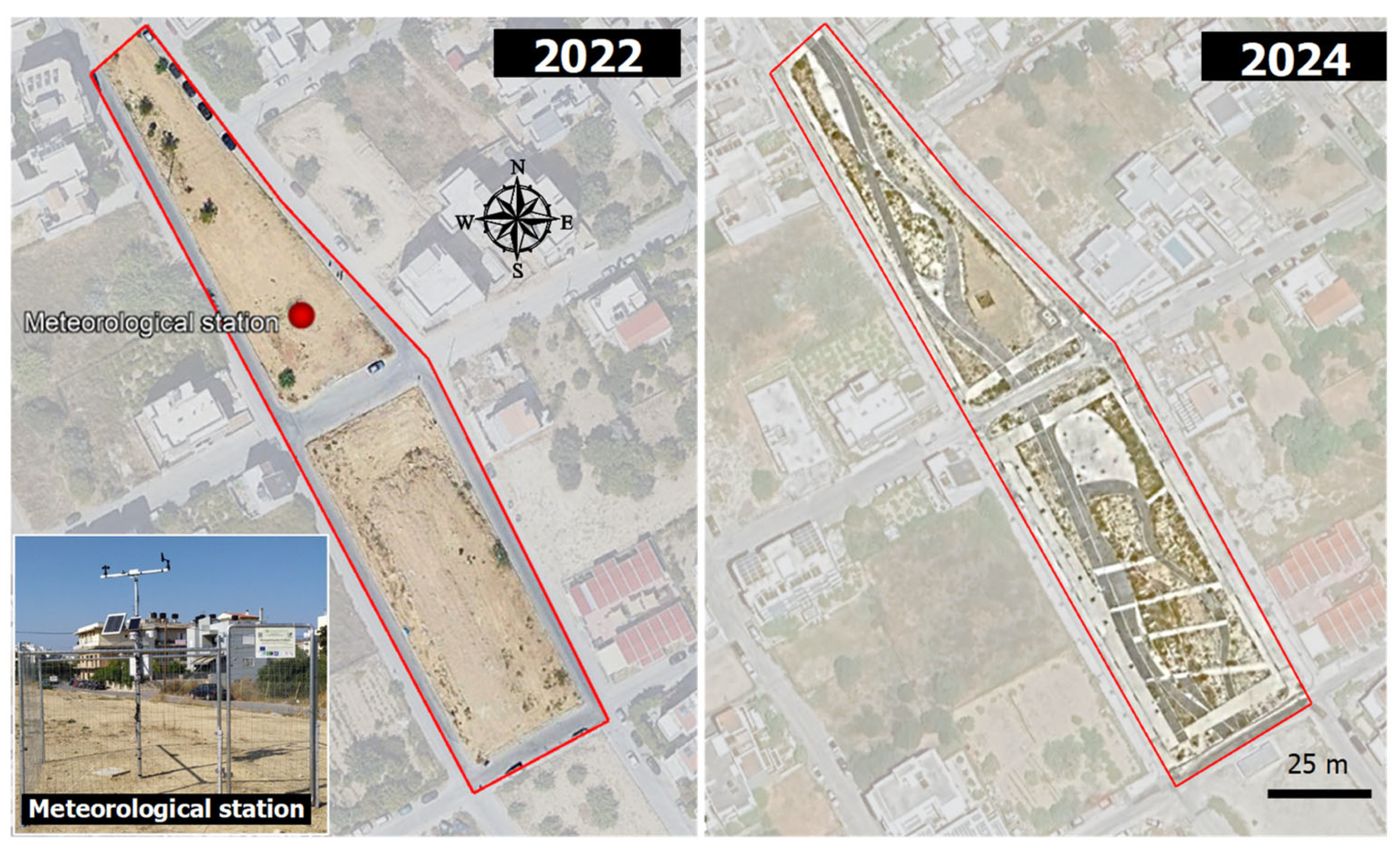
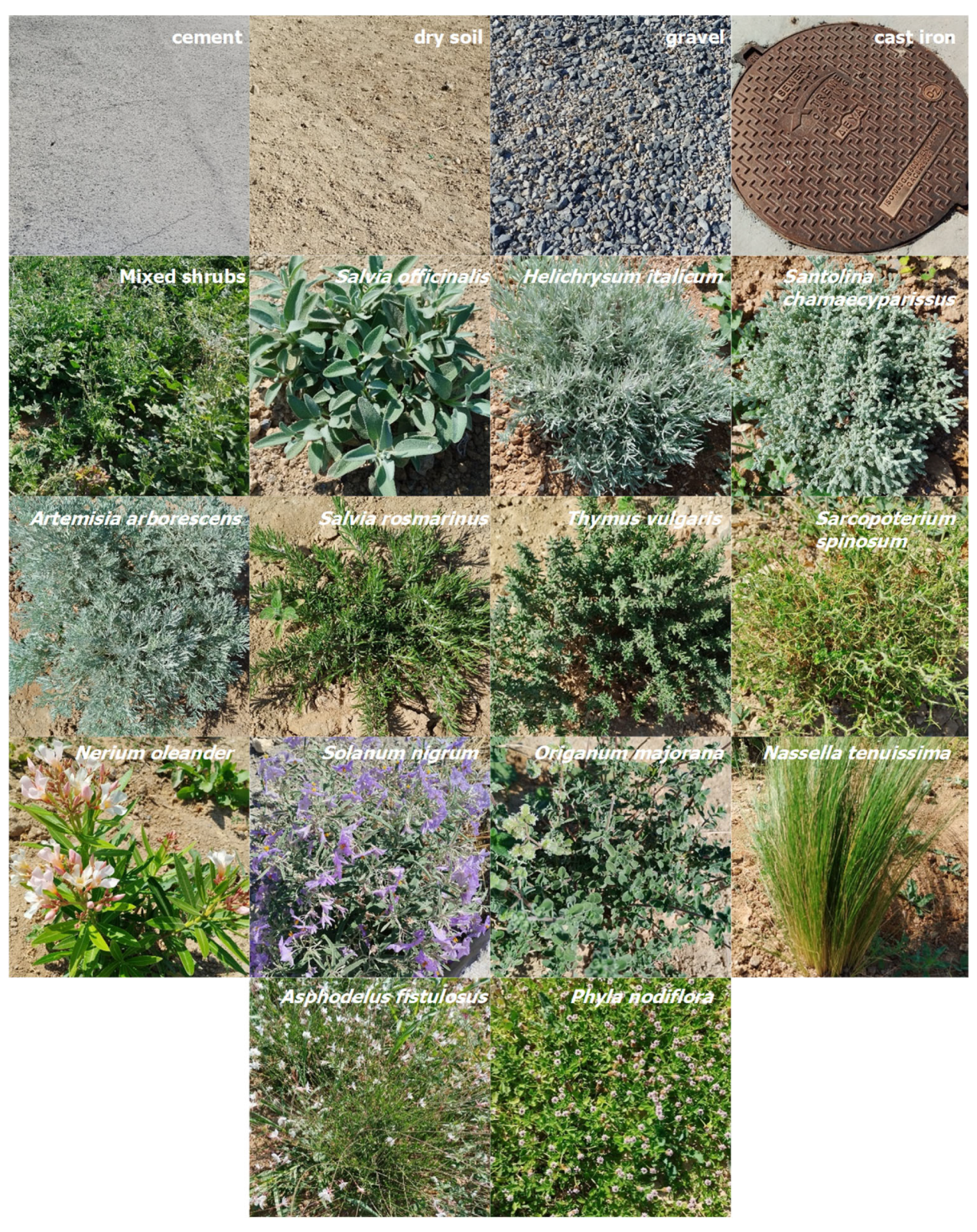

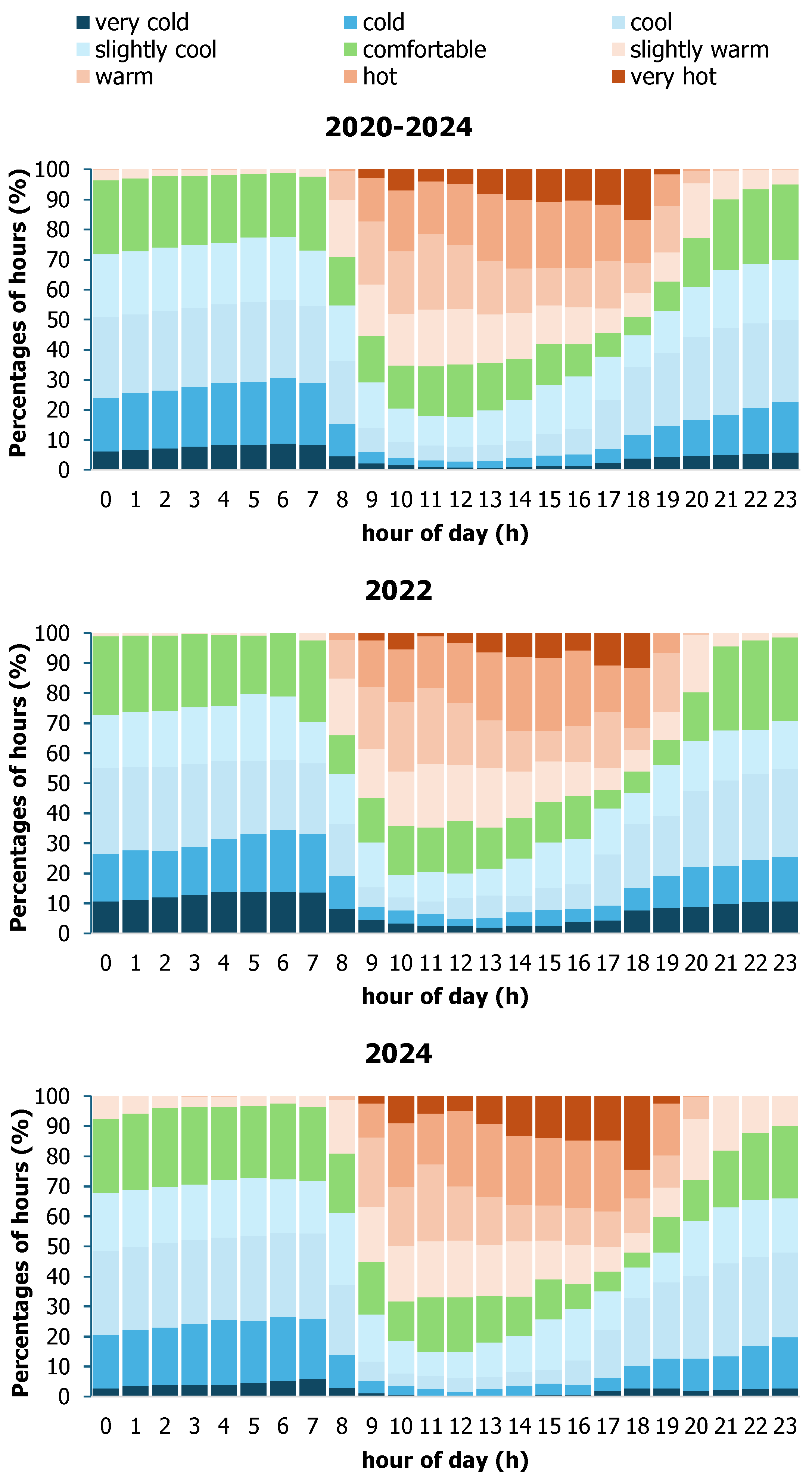

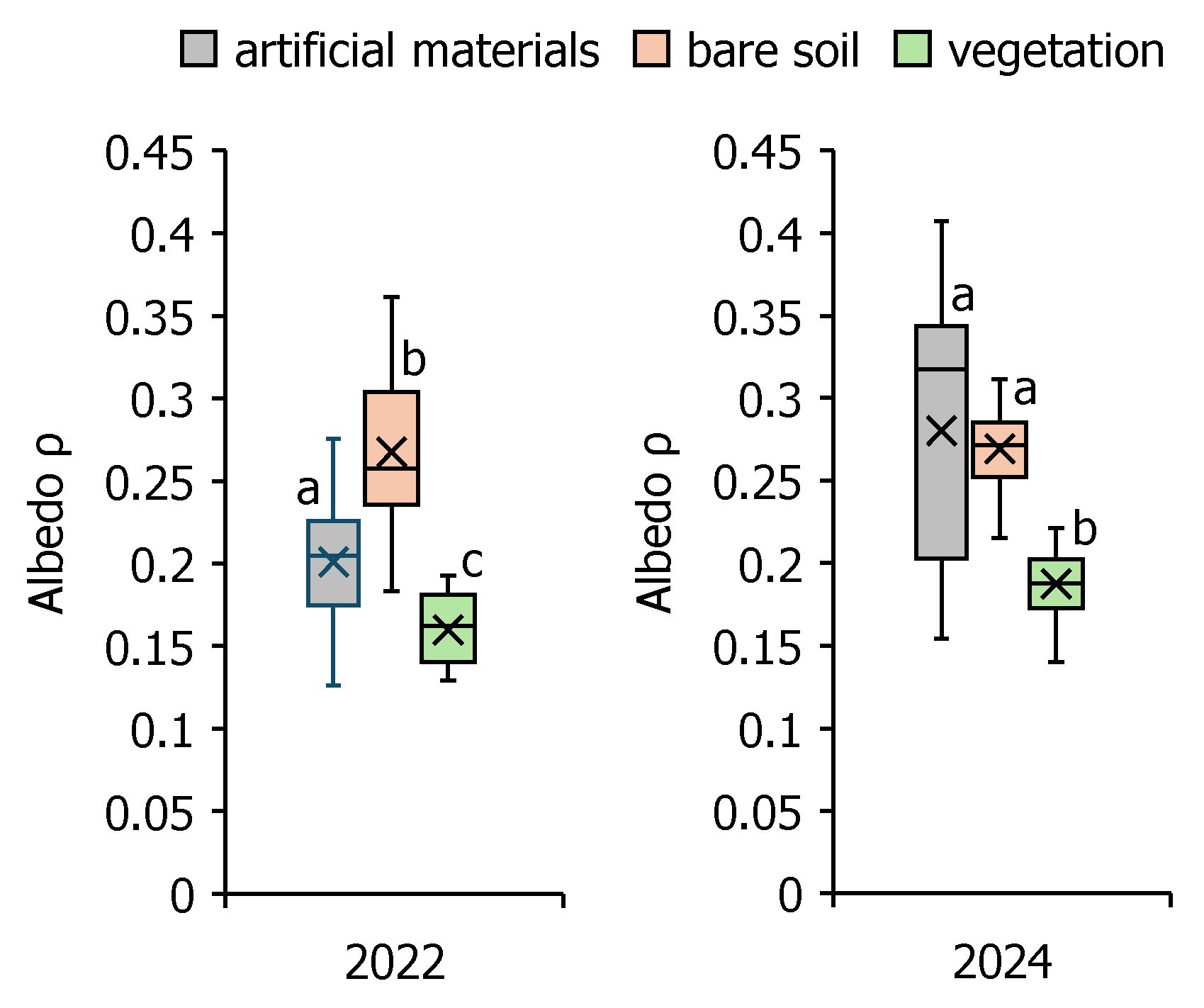
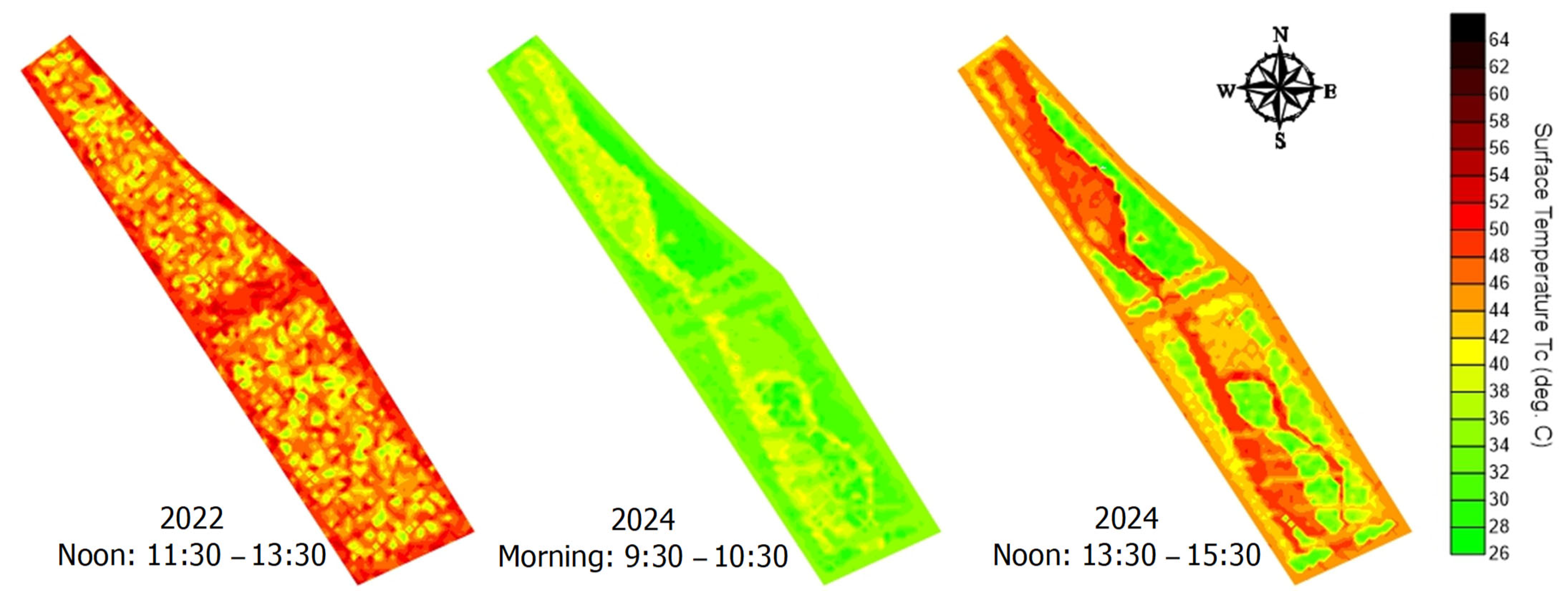
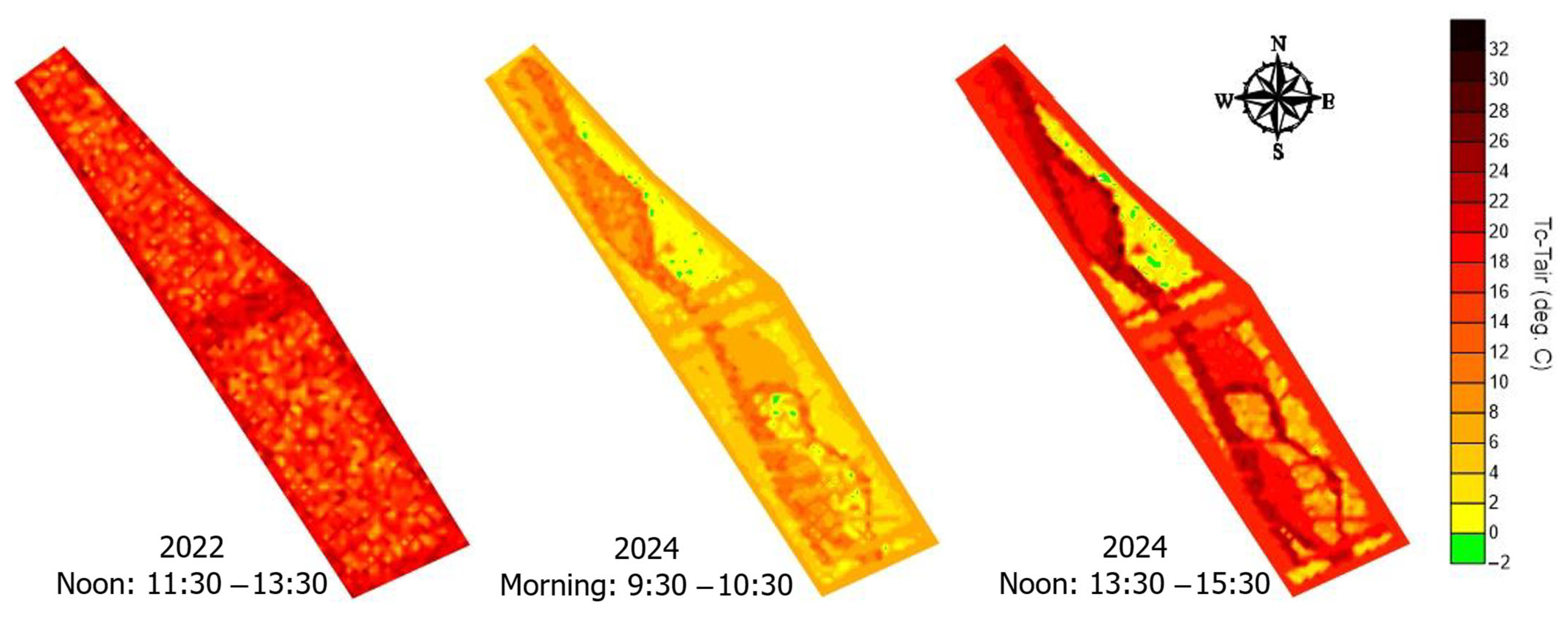


| Month | 2020 | 2021 | 2022 | 2023 | 2024 | |
| 1 | −2.5 | −1.9 | −2.6 | −1.9 | −2.1 | |
| 2 | −2.0 | −1.8 | −2.2 | −2.4 | −1.8 | |
| 3 | −1.5 | −1.9 | −2.6 | −1.5 | −1.2 | |
| 4 | −0.9 | −0.7 | −0.6 | −0.9 | −0.4 | |
| 5 | 0.6 | 0.6 | 0.2 | −0.4 | 0.1 | PMV classification |
| 6 | 1.0 | 1.2 | 1.2 | 0.8 | 1.6 | +3 hot |
| 7 | 1.5 | 1.8 | 1.4 | 1.9 | 1.8 | +2 warm |
| 8 | 1.5 | 1.8 | 1.5 | 1.6 | 1.8 | +1 slightly warm |
| 9 | 1.1 | 0.7 | 0.9 | 0.8 | 1.0 | 0 neutral |
| 10 | 0.3 | −0.4 | −0.3 | 0.2 | 0.1 | −1 slightly cool |
| 11 | −1.3 | −0.9 | −1.0 | −0.5 | −1.2 | −2 cool |
| 12 | −1.6 | −2.0 | −1.4 | −1.3 | −1.8 | −3 cold |
| Month | 2020 | 2021 | 2022 | 2023 | 2024 | |||
| 1 | 7.6 | 10.3 | 6.9 | 10.1 | 9.5 | |||
| 2 | 10.1 | 11.0 | 9.2 | 8.3 | 11.1 | PET (°C) classification | ||
| 3 | 12.7 | 11.0 | 7.1 | 12.5 | 14.2 | PET (°C) | Thermal Perception | Grade of Physical stress |
| 4 | 16.3 | 17.1 | 17.6 | 15.7 | 18.9 | >41 | Very hot | Extreme heat stress |
| 5 | 24.2 | 24.4 | 22.2 | 18.4 | 21.5 | 35–41 | Hot | Strong heat stress |
| 6 | 26.5 | 27.4 | 27.3 | 25.0 | 29.9 | 29–35 | Warm | Moderate heat stress |
| 7 | 29.0 | 30.1 | 28.2 | 30.7 | 30.4 | 23–29 | Slightly warm | Slight heat stress |
| 8 | 29.0 | 30.5 | 28.4 | 28.8 | 30.0 | 18–23 | Comfortable | No thermal stress |
| 9 | 26.1 | 24.5 | 25.2 | 24.6 | 26.1 | 13–18 | Slightly cool | Slight cold stress |
| 10 | 22.1 | 18.3 | 18.6 | 21.6 | 21.2 | 8–13 | Cool | Moderate cold stress |
| 11 | 12.9 | 15.6 | 14.7 | 17.4 | 14.1 | 4–8 | Cold | Strong cold stress |
| 12 | 11.6 | 9.5 | 12.7 | 12.8 | 10.8 | ≤4 | Very cold | Extreme cold stress |
Disclaimer/Publisher’s Note: The statements, opinions and data contained in all publications are solely those of the individual author(s) and contributor(s) and not of MDPI and/or the editor(s). MDPI and/or the editor(s) disclaim responsibility for any injury to people or property resulting from any ideas, methods, instructions or products referred to in the content. |
© 2025 by the authors. Licensee MDPI, Basel, Switzerland. This article is an open access article distributed under the terms and conditions of the Creative Commons Attribution (CC BY) license (https://creativecommons.org/licenses/by/4.0/).
Share and Cite
Proutsos, N.D.; Solomou, A.D.; Stefanidis, S.P. From Bare Soil to Green Infrastructure: Micrometeorological Benefits from the Restoration of a Small Urban Park in a Mediterranean City. Land 2025, 14, 1681. https://doi.org/10.3390/land14081681
Proutsos ND, Solomou AD, Stefanidis SP. From Bare Soil to Green Infrastructure: Micrometeorological Benefits from the Restoration of a Small Urban Park in a Mediterranean City. Land. 2025; 14(8):1681. https://doi.org/10.3390/land14081681
Chicago/Turabian StyleProutsos, Nikolaos D., Alexandra D. Solomou, and Stefanos P. Stefanidis. 2025. "From Bare Soil to Green Infrastructure: Micrometeorological Benefits from the Restoration of a Small Urban Park in a Mediterranean City" Land 14, no. 8: 1681. https://doi.org/10.3390/land14081681
APA StyleProutsos, N. D., Solomou, A. D., & Stefanidis, S. P. (2025). From Bare Soil to Green Infrastructure: Micrometeorological Benefits from the Restoration of a Small Urban Park in a Mediterranean City. Land, 14(8), 1681. https://doi.org/10.3390/land14081681









